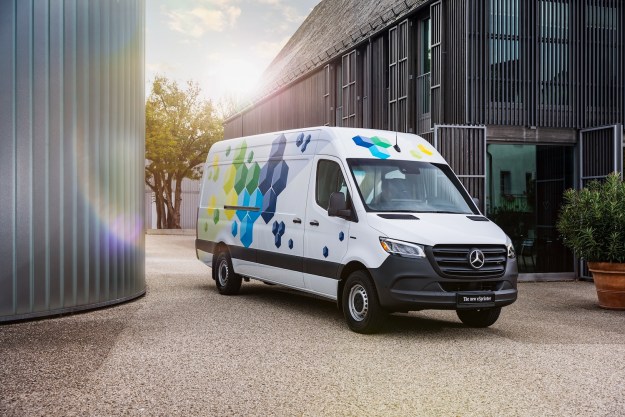
While best known for luxury cars, Mercedes-Benz is also a prolific maker of commercial vans. Since it first arrived in the U.S. in 2001, the Mercedes-Benz Sprinter has become a favorite of both delivery fleets and camping enthusiasts. And with Mercedes kicking its electrification plans into high gear, we’re finally getting an all-electric Sprinter van.
The 2024 Mercedes-Benz eSprinter is an updated version of a model Mercedes was already selling in Europe but was considered unsuitable for the U.S. because of its limited driving range. The updated eSprinter addresses that with a bigger battery pack and features a reengineered electric motor and other components that allow it to be built more easily alongside conventional vans. That’s happening at Mercedes’ factory in North Charleston, South Carolina, which will begin supplying electric vans to customers in the U.S. later this year.
Those customers will have a choice of standard ($74,181) and high-output ($77,611) versions, but not the variety of body styles available for internal-combustion vans, as well as the rival Ford E-Transit. For now, Mercedes is focusing on delivery services and other businesses needing lots of cargo space, but the #VanLife crowd will likely be eyeing the eSprinter as well.
Design and interior
The eSprinter looks like a standard Sprinter van, boasting the same European-style tall-and-narrow look that Mercedes popularized in the U.S. The current Sprinter design has been around since the 2019 model year, but Mercedes has been selling Sprinters in the U.S. for just over two decades. When the Sprinter first arrived, It stood out among the squat Ford E-Series and Chevrolet Express vans of the time. But since then, other automakers have followed Mercedes’ lead. Ford replaced the E-Series with the Euro-style Transit, while Stellantis currently sells the Fiat-derived Ram ProMaster.
To make a Sprinter into an eSprinter, Mercedes bolts a battery pack to the underside of the frame, slots in a compact electric motor to power the rear axle, and stuffs ancillary hardware under the hood in the space vacated by the combustion engine. Ford follows a similar formula with its E-Transit, which shares nearly everything but its powertrain with internal-combustion Transit models.
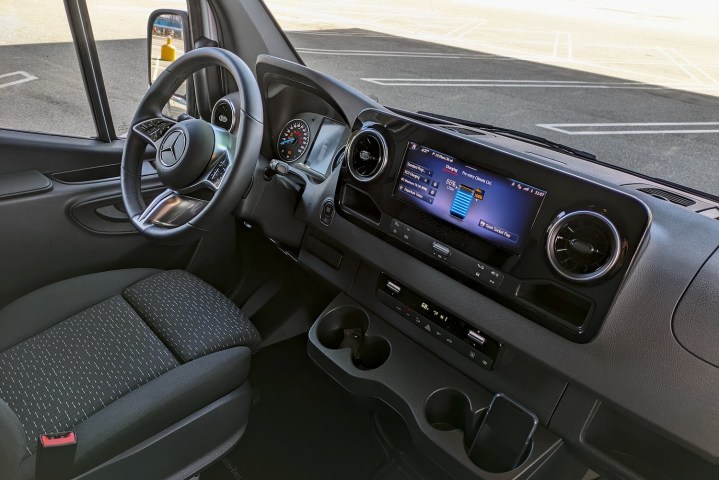
But there’s more creativity happening in the electric van world. Rivian has a purpose-built electric van, while General Motors has launched an entire electric van division called BrightDrop. Kia has even proposed building electric vans with swappable bodies, allowing them to switch from hauling cargo to passengers.
The interior looks vaguely similar to one from a Mercedes car, with fewer luxuries.
Mercedes will offer multiple configurations in other markets, but in the U.S., the eSprinter launches exclusively as a high-roof cargo van with a 170-inch wheelbase. Mercedes claims 488 cubic feet of cargo volume with a maximum payload capacity of 2,624 pounds. For comparison, Ford claims a maximum 3,553-pound payload capacity and 404.3 cubic feet of cargo space for equivalent versions of its E-Transit cargo van, which have a 148.0-inch wheelbase. The two configurations currently available for Rivian’s van land on either side of the eSprinter with a 157.5-inch wheelbase and 2,734-pound payload capacity and a 187.0-inch wheelbase and 2,513-pound payload capacity. GM claims a lower payload capacity but more cargo space for the larger of its two BrightDrop vans, the Zevo 600.
The interior also carries over from the internal combustion version of the Sprinter, meaning it looks vaguely similar to the cabins of Mercedes cars but without most of the creature comforts. Some of the details, such as the steering wheel, round air vents, and some of the dashboard controls, look like they came straight out of a GLC-Class. But this is a work vehicle, so you won’t find any massaging seats, Burmester audio systems, or delicately stitched leather upholstery.
Tech, infotainment, and driver assist
Whether internal combustion or electric, Sprinter vans get a version of the Mercedes-Benz User Experience (MBUX) infotainment system used in the automaker’s passenger cars, including wireless Apple CarPlay and Android Auto connectivity. In the eSprinter, MBUX runs on a 10.25-inch touchscreen that looks tiny in its plastic perch on the dashboard but is still more than adequate for basic functions like navigation and vehicle settings.
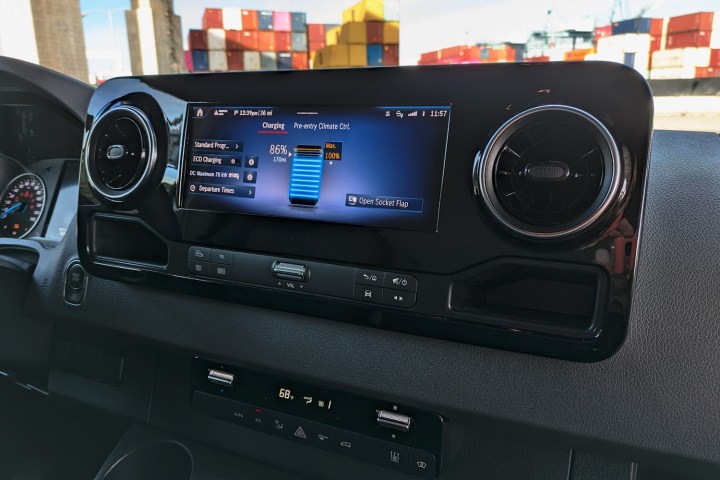
The eSprinter features the same excellent voice recognition system as other Mercedes models, which is generally more reliable than equivalent systems from other automakers. An EV-specific navigation feature is also available, incorporating charging stops into the route. We didn’t have an opportunity to test out the latter feature during our short test drive, but voice control worked just as well as in the Mercedes passenger cars we’ve used it in.
Driver-assist features like automatic emergency braking, blind-spot monitoring, and a driver-attention monitor are also available, but you won’t find the more sophisticated driver aids available in Mercedes’ passenger cars. The available rearview camera mirror seems like it should have been deployed in vans before passenger cars rather than the other way around.
Driving experience
All eSprinter models are rear-wheel drive, but as noted above, Mercedes offers two power levels. Buyers get 134 horsepower standard but can also specify 201 hp, with 295 pound-feet of torque in either case.
While automakers often launch electric cars that are more powerful than their internal-combustion counterparts to help sell EV tech, that wasn’t a priority for Mercedes with the eSprinter. The four-cylinder diesel engine that comes standard in the non-electric Sprinter only makes 170 hp, but it matches the eSprinter’s electric motor’s torque. Mercedes offers a more powerful version of the diesel, rated at 211 hp and 332 lb-ft of torque.
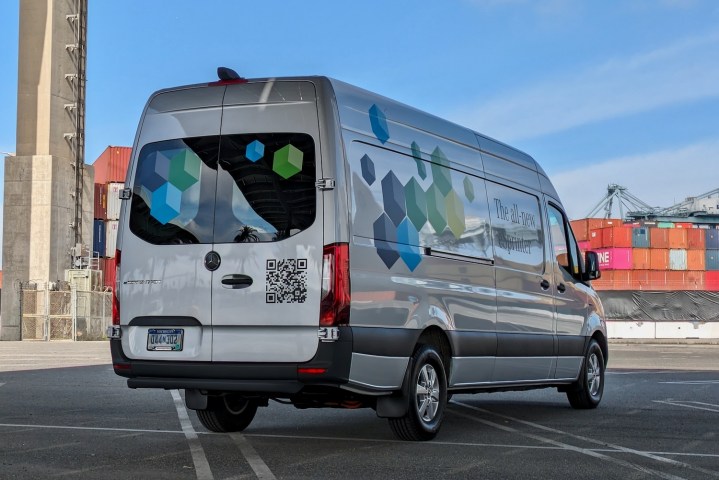
The eSprinter’s top speed is also limited to a reasonable 75 mph, which is probably just as well for a vehicle that will likely spend most of its working life with a GPS speed tracker installed. Acceleration up to that speed is good for a van but leisurely for an EV. But, for what it’s worth, the eSprinter is overall much nicer to drive than a diesel Sprinter. It felt remarkably nimble for such a large vehicle, something Mercedes attributes to the low-mounted battery pack. And despite the lack of an internal combustion engine to mask wind noise and reverberations from the cavernous cargo hold, the cab was also fairly quiet.
The eSprinter is much nicer to drive than a diesel Sprinter.
Mercedes supplies a selection of drive modes that let you know exactly what kind of vehicle you’re driving. The only choices are Comfort, Eco, and Maximum Range. Comfort mode is a bit of a misnomer, as it’s essentially the default mode, allowing full power from both the motor and climate control, as well as the most immediate accelerator response. Eco and Maximum Range modes dial everything back to save energy, but to the point that acceleration felt too sluggish even for slow traffic.
The eSprinter also has something that should be on every electric passenger car: multiple levels of regenerative braking. Drivers can toggle through multiple settings of regen strength, including one that turns regenerative braking completely off and lets the van coast. An automatic mode lets the van choose the level of regen based on the speed of vehicles in front and the topography of the road.
Range and charging
One of the reasons Mercedes didn’t bring the original eSprinter to the U.S. was what the automaker deemed to be an inadequate range, something that’s been addressed with a bigger battery pack. The 113-kilowatt-hour pack also uses lithium iron phosphate (LFP) chemistry, also used in certain Ford Mustang Mach-E and Tesla models. Mercedes claims it is a better fit for light commercial vehicles like vans because it degrades at a slower rate.
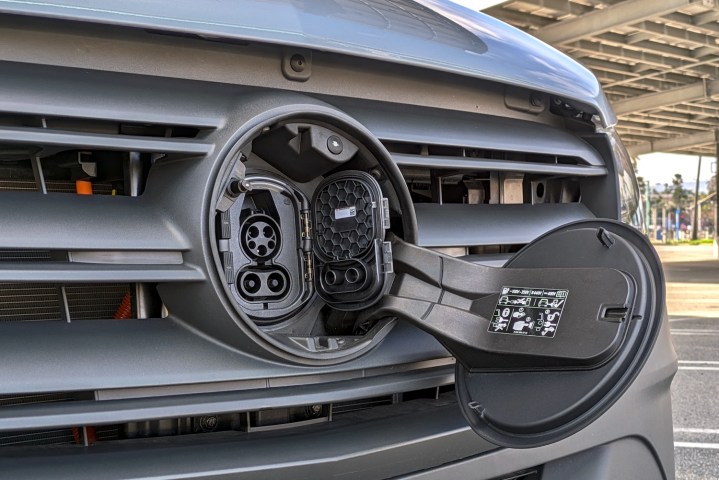
U.S. range figures weren’t available at press time, and because its maximum 9,370-pound gross vehicle weight rating (GVWR) is past the cutoff for light-duty vehicles, the eSprinter likely won’t undergo formal testing for the U.S. Mercedes estimates a range of about 250 miles, which would put the eSprinter well ahead of the Ford E-Transit, which can only manage 108 miles when comparably configured, as well as Rivian’s vans, but about even with GM’s BrightDrop vans.
DC fast charging at 115 kilowatts can take the battery from 10% to 80% charge in an estimated 42 minutes. A full recharge from a 240-volt AC charger takes 12.5 hours. For public charging, Mercedes also offers connectivity that lets drivers start and pay for charging at three of the biggest networks – ChargePoint, Electrify America, and EVgo — without using each network’s individual app. What Mercedes hasn’t included is any provision for tapping into the battery pack to run appliances or other accessories for camper van conversions. That’s just not a priority, as the initial rollout of the eSprinter is focused on business customers.
How DT would configure this car
If we were speccing an eSprinter, we’d go with the higher-output 201-hp version. It felt merely adequate, so we weren’t exactly eager to drive a less-powerful version.

Most eSprinter drivers won’t get to choose what they’re driving, though. While some will likely make it into private hands eventually, the first buyers will be businesses shopping these roughly $70,000 vans against cheaper Ford E-Transits with more configuration options but less range, and pricier Rivians with sleeker styling and the cool factor of one of the hottest EV startups.
The quick growth of the electric van market could be a big win for the environment.
Regardless of which van wins over fleet managers, the quick growth of the electric van market could be a big win for the environment, reducing emissions from vehicles that cover vastly more mileage than the average passenger car and lowering the carbon footprint of the products we buy.
Even Mercedes doesn’t think the eSprinter is the ultimate electric van, though. The automaker is already planning new medium and large vans based on an EV-specific architecture called Van.EA. The first of these vans is scheduled to debut in 2026. For now, the eSprinter is a great first effort, bringing smart tech and electric power to the humble delivery van.
Editors' Recommendations
- 2025 Mercedes-Benz EQS sedan gets new face, bigger battery
- 2024 Mercedes-AMG S63 E Performance first drive review: high-performance plug-in
- Mercedes-Benz brings ChatGPT voice control to its cars
- Mercedes-Maybach EQS SUV is old-school luxury — electrified
- Mercedes-Benz EQE SUV first drive review: ’90s look, cutting-edge tech

